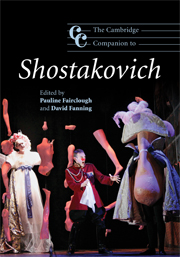Book contents
- Frontmatter
- Introduction
- PART I Instrumental works
- PART II Music for stage and screen
- PART III Vocal and choral works
- PART IV Performance, theory, reception
- 12 A political football: Shostakovich reception in Germany
- 13 The rough guide to Shostakovich's harmonic language
- 14 Shostakovich on record
- 15 Jewish existential irony as musical ethos in the music of Shostakovich
- Notes
- Select bibliography
- Index
14 - Shostakovich on record
from PART IV - Performance, theory, reception
Published online by Cambridge University Press: 28 September 2011
- Frontmatter
- Introduction
- PART I Instrumental works
- PART II Music for stage and screen
- PART III Vocal and choral works
- PART IV Performance, theory, reception
- 12 A political football: Shostakovich reception in Germany
- 13 The rough guide to Shostakovich's harmonic language
- 14 Shostakovich on record
- 15 Jewish existential irony as musical ethos in the music of Shostakovich
- Notes
- Select bibliography
- Index
Summary
With the completion of his First Symphony on 1 July 1925, two months before his nineteenth birthday, Shostakovich had already travelled further in stylistic terms than many composers do in a lifetime. Yet such was the pace of his artistic development and his urge for self-realization that he ran headlong into a crisis of confidence, from which he emerged almost as precipitately:
Starting in the autumn of 1925 and continuing to December 1926, I kept trying to compose, but unsuccessfully …[M]y creative consciousness could not escape the bounds inculcated by academic canons. From autumn 1926 I turned to the study of contemporary Western composers (Schoenberg, Béla Bartók, Hindemith, Krenek), which apparently provided the immediate stimulus for ‘liberating’ my musical faculties: my first compositions from this new period were composed in white heat (from the end of 1926 through 1927).
And there was another change of direction that Shostakovich had to negotiate at this time. In January 1927 he took part in the first Chopin Piano Competition in Warsaw, where he was one of eight finalists but not a prizewinner (his Moscow-based friend Lev Oborin won first prize, and the now legendary Grigory Ginzburg came fourth). He put the outcome down to a combination of pain from appendicitis and chauvinism on the part of an all-Polish jury. Be that as it may, it was a disappointment that was to mark the end of his serious aspirations as a concert artist, and his solo appearances gradually reduced in number.
- Type
- Chapter
- Information
- The Cambridge Companion to Shostakovich , pp. 325 - 349Publisher: Cambridge University PressPrint publication year: 2008



